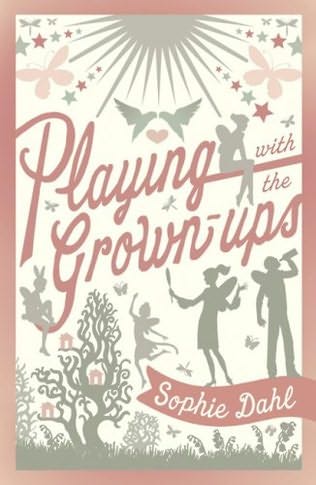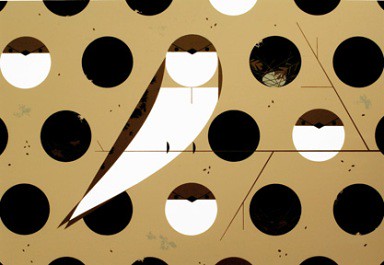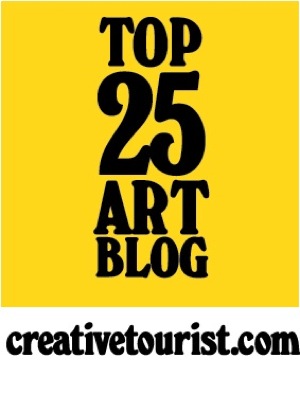
I’ve just finished reading Sophie Dahl’s first novel, Playing with the Grown-ups, which left me with an itch to pinpoint exactly what it was I found so peculiar about reading it.
I’ll admit that I did approach the book with a certain degree of initial trepidation. After all, the cover is very pink, with butterflies and curly-wurly writing; and what is more, no one could say that the notion of a “somewhat autobiographical” first novel from a world-famous supermodel exactly inspires an instant vote of confidence. However, I was also genuinely prepared to enjoy this book: for one thing, I do actually quite like butterflies and pink things, and for another, in spite of the apparent “double jinx” effect of being simultaneously both an extremely beautiful celebrity, and the grand-daughter of one of Britain’s best-loved writers, Dahl does strike one as someone not short of a brain cell or two. Her previous novella, The Man with the Dancing Eyes (2003) was very enjoyable (in spite of taking the concept of “whimsy” to whole new levels) and she has since written some interesting pieces for Vogue and The Guardian. More tellingly, however, Playing with the Grown Ups has also received some very favourable reviews in the press, being compared by a number of critics to not just one but two of my all-time-favourite-ever books: Nancy Mitford’s The Pursuit of Love and Dodie Smith’s I Capture the Castle. As far as I am concerned there isn’t really higher praise than that. For extra reassurance, the book’s cover is laced with lavish recommendations from everyone from Time Out (“a lush and rhapsodic coming-of-age novel”) to ELLE (“lyrical, knowing and stylish”). The only potential warning sign is a thumbs-up from Cecilia Aherne, who I have to admit is not a favourite of mine – I did manage to survive PS., I Love You, but only barely.
Anyway, Aherne aside, I was feeling pretty good about settling down to read Playing with the Grown-ups, which was shaping up to be everything I like best in an easy-going, escapist, Saturday-afternoon kind of read. But 100 or so pages later, I was feeling confused, even a little cheated. The book I was reading didn’t seem to bear any real connection to most of the reviews on the cover. Was I even reading the same book?
Now, before we go any further, I have to point out here that this isn’t going to be a hatchet job on Dahl’s novel. Frankly, I think she has enough to contend with as a famous-supermodel-cum-author-cum-girlfriend-of-Jamie-Cullum without getting into that sort of unhelpful sniping. It is, after all, a first novel - and besides, I think it really does have quite lot going for it: there are some very sharp, sensitive observational moments; it is often genuinely funny; and I enjoyed the touches of early-90s nostalgia. Broadly speaking, the story follows Kitty, a young girl growing up at the idyllic Hay House, where she lives with her “eccentric” English family: grandparents, teenage aunts, half-siblings and her glamorous but temperamental young mother, Marina, an artist and “spectacular beauty” whose whims pull Kitty away from her familiar childhood home and whisk her through a string of new and strange locations – from a slightly grim boarding school to a ritzy New York apartment to an ashram. The narrative is framed by sections which focus on Kitty in the present day – now grown up and pregnant by her rather sickeningly perfect husband – returning from New York to the UK following her mother’s overdose. Though she doesn’t always quite convince, the character of Kitty is thoughtfully drawn, and certainly a lot more subtle than some of the overworked “eccentric” figures who are amusing but not always very believable – even Marina herself always remains something of a try-hard bohemian stereotype, although interestingly Dahl has acknowledged that her character is largely based upon her own mother, Tessa Dahl. But where the novel really falls down for me is when it tries to be Deep or possibly Serious, and thus slides into cringe (or giggle)-inducing psychobabble and melodrama – at times, there is just the tiniest hint of Dawson’s Creek. The occasionally rather overwrought and self-conscious prose style doesn’t help matters: I could have done without the references to "spectacular" beauty and "silver eyes" though as Katy Guest, writing in The Independent points out "any writer who uses the line, 'She was in bed wearing a silk peignoir' with a straight face deserves a prize."
There’s something more than language, though, that bothered me about this book - which, when Dahl relaxes and lets herself go, is actually rather gracefully written. I think the closest I can come to it is a very classic and clichéd piece of advice (which I have been given myself in the past...perhaps, dare I suggest, many of the things which disappointed me most about Dahl’s writing are the very things that frustrate me about my own?) and that is “murder your darlings”. What’s really wrong with Playing with the Grown-ups is that there’s no sting in the tale, no bite. In spite of the rather tedious roll-call of the usual ‘misery-lit’ ingredients - drugs (check), alcohol (check), sex (check), dysfunctional family life (check), hints at eating disorders (check), self-harm (check), tragic beauties (check) nothing seems to have consequences. Far from being dark, it’s actually all rather glossy and well-lit: you can imagine everyone a little bit wooden, but with perfect hair, like characters in a made-for-TV movie. In spite of all, at the end of the book, the now supposedly well-adjusted grown-up Kitty seems to have a cringingly ‘nice’ relationship with her family, whilst Marina herself is rather too neatly ‘punished’ for her insensitive ways by turning out to be a bit of a sad case. Dahl has been quoted as saying how much she hates “bitter books and bitter people” and I’m the last person to advocate for the grim and the joyless in the books I read, but it all just seems a little bit gooey – like eating a lot of cream cakes - maybe whimsical pink ones, possibly with some kind of star-shaped sprinkles on top?Now I don’t mean to imply that Dahl ought to have written a misery memoir (let's just say I am not a fan of those), and of course, a lovely, light-as-air, enjoyable cream-cake of a book, even if it is a bit sugary at times, is not automatically a bad thing, especially when it has that extra touch of magic-wand sparkle to it. However, by the end - I’ll admit it - I was desperate for something to take the edge off all that sticky sweetness.
For me though, it is not simply the over-the-top praise the book received, but the endless comparisons to Smith, Mitford (and on occasion, Evelyn Waugh) that are the most baffling. OK, so Dahl is writing about the experience of being a teenage girl, and yes, she clearly has that whole English-rose-eccentric-aristo thing going for her, but beyond that I am slightly confused. Have any of these reviewers actually read The Pursuit of Love? I can just about countenance the idea of Kitty as a sort of parallel Fanny, though I can’t somehow quite imagine Fanny skipping school or going on a coke binge, not to mention wearing white jeans, even if she had happened to live in the 1990s. But Marina as The Bolter, frankly, is just a bit of an insult to the poor old Bolter. The Bolter would never have gone down the road of self-harm or drug overdoses. She didn’t need to find herself in an ashram. She was quite happy just being the Bolter, really. I think that was always the point.
Having said that, is it really just that Nancy Mitford just happens to be
en vogue at the moment, and so is a sort of shorthand for a vaguely stylish kind of book (after all, it has been written by a supermodel) that would go well with your Christopher Kane by Burberry or maybe your Alice Temperley tea gown? I don’t know. It’s all a bit of a mystery to be honest. Still I did eventually manage to track down one review of the book that seemed more in line with my own take on it -
Katy Guest’s in the Independent which gives a much more balanced reading of
Playing with the Grown-ups. Even though she does go down the whole Mitford/Waugh avenue, Guest qualifies it by describing Dahl’s novel as “like Mitford and Waugh after they’ve worked through their issues with an understanding therapist.” Hmmmm. Quite.
I suppose if there’s one thing all this proves, it’s that age-old truism “don’t judge a book by its cover” – or by the strap-lines on its cover anyway. Most of all, I think what was peculiar about reading this book was the disjunction between the PR spin and the book itself - which gave me a sharp reminder of just how vitally important marketing and PR is in today’s publishing world. It left me wondering if, when so many talented writers have an uphill struggle to even get a manuscript looked at by a serious agent or commercial editor, a slightly uneven first novel would attract anywhere near this level of rhapsodic (or even hyperbolic) praise and critical attention if it wasn’t penned by a marketable celebrity – and thus, something of a guaranteed “cash cow”.
On the plus side though - and just to finish on a less cynical note - it is fantastic to see that it is still possible for new writers to get published in spite of being (shockingly) non-celebrities - or so far, at least! Can I please direct your attention to
Jenn Ashworth's first novel
A Kind of Intimacy which is due out next month from Arcadia Books, and has already been selected for
Waterstone's New Voices 2009 promotion . If you go to her blog
here you'll have the chance to win a copy - if you're very clever that is!
 I love Saturdays.
I love Saturdays.































